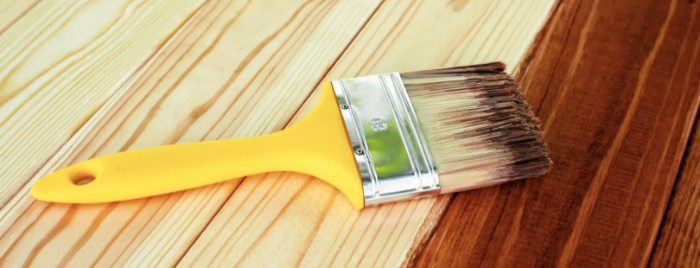Staining is a popular interior decorating technique that enhances wooden surfaces by altering color and preserving the natural grain. From gel to oil-based stains, it not only transforms appearance but also protects against wear, moisture, and UV rays, making it a practical choice for visually appealing and durable wooden features.
What Is Staining?
Staining is a common technique used in interior decorating, specifically to highlight and preserve the natural appeal and toughness of wooden surfaces. This method involves the application of a pigment or dye onto a wooden surface to alter its colour, while also letting the wood's unique grain - which is the characteristic pattern generated by the tree's growth rings - remain intact.
The process of staining doesn't solely change the colour, it also helps in improving the general aesthetic of different items such as furniture, flooring and decorative features. Contrary to paint, which creates a coating on the wood's surface, staining seeps into the wood itself.
In doing so, the timber's natural qualities can then mirror the appearance of more high-priced wood types; all while avoiding the hefty cost. Staining is a diverse and dynamic tool in interior design and decoration, resulting not only in a colour revamp but also in the refinement of the wood's innate beauty. This, in turn, helps to make any space more visually appealing and personalised to the owner's preferences. It's a practical and cost-effective alternative to getting the feel of expensive wood without paying a large price for it.
What Are The Types Of Staining Used In Interior Decoration?
Interior staining is a popular technique used extensively within interior design and decorating. It's used to enrich the appeal of various wooden features within a property - from enhancing the attractiveness of stairs, cabinets, wooden floors and more.
Gel wood stain
Gel wood stain is a great tool when it comes to interior decorating; its formulation, usually oil or varnish-based, lends it a thick consistency, making it extremely easy to apply. These stains consist of robust pigments that add rich, vibrant hues to your wood furnishings, providing a unique aesthetic appeal. Despite its thick consistency, the application is usually simple, requiring either a brush or cloth.
Due to the denseness of the stain, it doesn't tend to drip and makes the whole process clean and tidy. However, gel wood stains lack deep penetration - unlike traditional oil-based wood stains, such as linseed oil or a mixture of oil and varnish, the gel stains don't soak into the wood; instead, they lay on the surface.
Lacquer wood stain
Lacquer wood stain is perfect for fast applications; this solvent-based stain has the added advantage of not yellowing with age. Varnish wood stains, on the other hand, are incredibly similar to oil-based wood stains, but they come with a distinctive feature - they dry to a hardened coating. These stains maintain a natural look due to their oil-based thinning agent and evoke a glossy wood finish.
Oil-based wood stain
Oil-based wood stain is known for its unique characteristic of penetrating the wood grain instead of merely sitting on the surface; it comprises linseed oil and varnish. This characteristic ensures the wood's long-lasting beauty, making it a go-to choice for many decorators. Water-based wood stain is an eco-friendly formula, setting it apart from other stains; it incorporates water-based dyes to lend colour to the wood, making it an appealing option for those conscious of their carbon footprint.
What Is The Purpose Of Staining?
In the realm of interior decorating, the process of staining is not only about elevating the visual appeal of a wooden item but it also comes with various practical uses. Staining is a method used to safeguard and preserve wood; it effectively shields the material from harmful elements like moisture and household pests. Over time, these factors can contribute to the wear and tear of an untreated wooden surface.
Moreover, staining provides a defence against fading and colour abnormalities that can be triggered by prolonged exposure to light. Another key advantage of staining is how it repels dirt and grime, rather than soaking them up. Choosing to stain your furniture or wooden surfaces can be a time-saving move, compared to painting.
The reason for staining wood in domestic settings is to essentially close off the microscopic pores within the wood. This ensures that the wood is prevented from absorbing any liquids such as water and preventing potential damage.
Besides offering this protection, wood staining also imbues the wood with a new, vibrant shade; to further its protective role, the stain also acts as a shield against the Sun's ultraviolet rays. This particular feature ensures the wood maintains its aesthetic appeal by greatly reducing, if not entirely preventing any discolouration caused by continued exposure to sunlight.

What’s The Difference Between Staining And Varnishing?
Staining and varnishing are two different methods commonly used in interior decoration, particularly when dealing with wooden surfaces. However, they perform distinct roles and produce different results on the wood. Staining primarily contributes to altering the colour of the wood, resulting in a more visually appealing finish.
On the other hand, varnishing serves a different purpose. Unlike staining, it doesn't typically change the colour of the wood, so it doesn't impact the visual aspect as much. Instead, the role of varnish is to act as a protective layer.
Wood varnishing is an integral process when it comes to interior decoration, as it plays a crucial role in preserving the appearance, durability, and longevity of wooden features within a property - as well as protecting them from potential damage.
Wood varnish doesn't usually change the colour of the wood, unlike wood staining which modifies the shade of the wood. It protects wooden furniture, cabinets, floors, and other interior furnishings over time; helping them withstand the potential damage caused by moisture, humidity and harmful ultraviolet rays from the sun. Varnishing wood is essential for maintaining wood, while also extending its lifespan.

Oil-Based Stain VS Water-Based Stain
In interior decorating, stains are often categorised into two types: oil-based and water-based. Each type of stain comes with its advantages and disadvantages. Oil-based stains are popular among professional interior decorators; one of their benefits is their longevity.
Oil-based stains
Oil-based stains are designed to stand the test of time as they provide a rich, vibrant colour - which allows the organic intricacy of the wood grain to shine through.
However, the potency of oil-based stains means they require a longer drying time. Additionally, oil-based stains have a prominent odour and emit fumes, requiring ventilation during application.
WATER-BASED STAINS
On the other hand, water-based stains are more odourless, making them easier on the senses during application. Water-based stains also dry quickly and are friendlier to the environment.
Where they can fall short is their penetration ability as water-based stains often don't permeate as deeply into the wood compared to oil-based counterparts.
When it comes to interior decorating, oil-based stains have a few notable advantages over water-based stains. Oil-based stains penetrate deeper into the wood since oil molecules are significantly smaller than water molecules; this allows them to infiltrate even the tiniest cracks, offering a long-lasting shield against moisture and UV rays.
Oil-based stains rarely peel or chip over time, which is a key factor in their longevity. Over the years, oil-based stains' durability and water resistance have led them to become one of the top choices for wood finishes.
On the other hand, an increase in ecological awareness has made water-based stains more popular. Oil-based products release volatile organic compounds (VOCs) into the air, which can harm the environment and human health. Moreover, water-based stains are environmentally friendly, as they do not emit harmful chemicals. It's clear that in terms of durability and protection, oil-based stains have an edge; therefore, they continue to be a popular choice for interior decoration.
Interior Painting Services Northampton
If you require further assistance on your painting and decorating, please contact our professional and experienced team of painters and decorators. We will be happy to help you redesign and decorate your home interior for maximum comfort and entertainment.
If you require interior painting and decorating services for Northampton or the surrounding areas, follow the link below.

